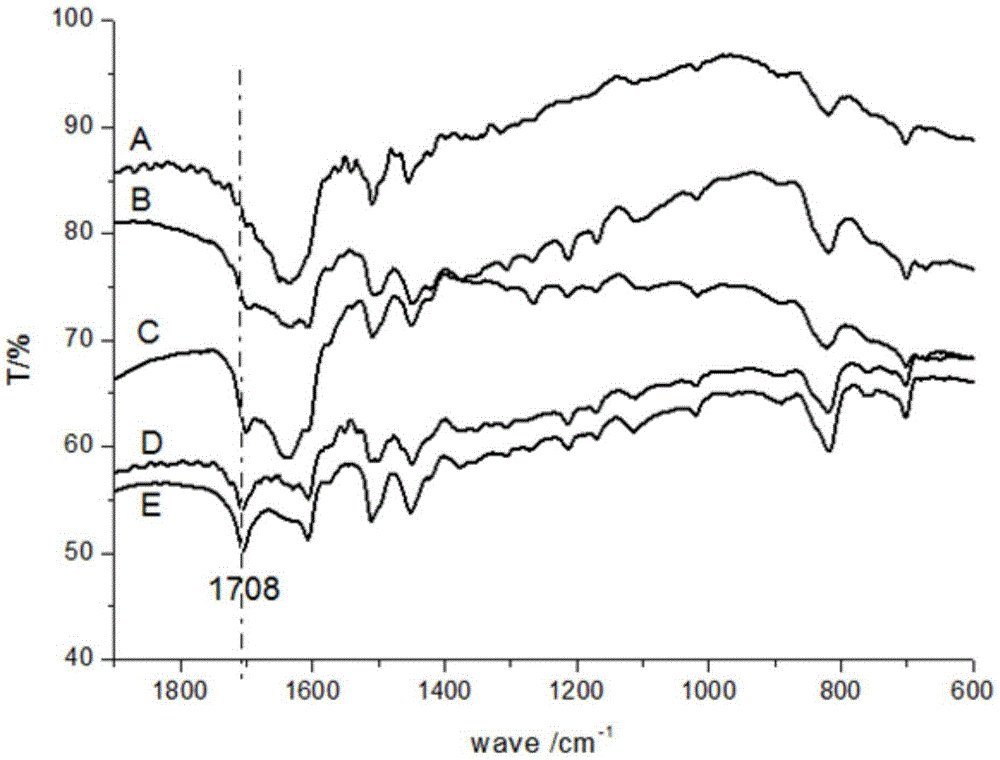Preparation method of secondarily-crosslinked adsorption resin
A technology for secondary cross-linking and resin adsorption, applied in chemical instruments and methods, other chemical processes, etc. Poor tolerance, etc.
- Summary
- Abstract
- Description
- Claims
- Application Information
AI Technical Summary
Problems solved by technology
Method used
Image
Examples
Embodiment 1
[0039] Step 1: The synthesis process of polystyrene resin white balls is as follows.
[0040] Add 500mL of an aqueous solution containing 1.5wt% gelatin into a 1000mL three-neck flask, stir and dissolve as the water phase.
[0041] Take a 500mL beaker, add 6.94g of divinylbenzene, 76.92g of styrene, 83.86g of toluene, 50.32g of 200# gasoline, and 0.5g of benzoyl peroxide into it, mix well to form an oil phase, and add it to a three-necked flask . Then the temperature was raised to 75°C under mechanical stirring, and the reaction was carried out for 7 hours, and then the temperature was raised to 85°C for 13 hours. After the reaction, the porogen was evaporated, washed with water until the washing solution was clear, then suction filtered, dried, and sieved, and the resin with a particle size of 0.4mm to 2mm was selected to obtain the desired polystyrene-divinylbenzene white ball ( A type of polystyrene resin white ball).
[0042] Step 2: The process of the chloromethylation...
Embodiment 2
[0048] Step 1: The synthesis process of polystyrene resin white balls is as follows.
[0049] Add 500mL of an aqueous solution containing 2.0wt% polyvinyl alcohol into a 1000mL three-neck flask, stir and dissolve it as the water phase.
[0050] Take a 500mL beaker, add 6.94g of divinylbenzene, 76.92g of styrene, 55g of toluene, 45g of 200# gasoline, and 1.0g of benzoyl peroxide into it, mix well to form an oil phase, and add it to a three-necked flask. Then the temperature was raised to 75°C under mechanical stirring, and the reaction was carried out for 7 hours, and then the temperature was raised to 85°C for 13 hours. After the reaction, the porogen was evaporated, washed with water until the washing solution was clear, then suction filtered, dried, and sieved, and the resin with a particle size of 0.4mm to 2mm was selected to obtain the desired polystyrene-divinylbenzene white ball ( polystyrene resin white balls).
[0051] Step 2: The process of the chloromethylation rea...
Embodiment 3
[0057] Step 1: The synthesis process of polystyrene resin white balls is as follows.
[0058] Add 500mL of an aqueous solution containing 2.0wt% polyvinyl alcohol into a 1000mL three-neck flask, stir and dissolve it as the water phase.
[0059] Take a 500mL beaker, add 18.52g of divinylbenzene, 74.08g of styrene, 87.97g of xylene, 69.45g of cyclohexane, and 0.5g of azobisisobutyronitrile into it. in the flask. Then the temperature was raised to 75°C under mechanical stirring, and the reaction was carried out for 5 hours, and then the temperature was raised to 85°C for 7 hours. After the reaction, the porogen was evaporated, washed with water until the washing solution was clear, then suction filtered, dried, and sieved, and the resin with a particle size of 0.4mm to 2mm was selected to obtain the desired polystyrene-divinylbenzene white ball ( polystyrene resin white balls).
[0060] Step 2: The process of the chloromethylation reaction is as follows.
[0061] First, add 3...
PUM
| Property | Measurement | Unit |
|---|---|---|
| pore size | aaaaa | aaaaa |
| particle diameter | aaaaa | aaaaa |
| pore size | aaaaa | aaaaa |
Abstract
Description
Claims
Application Information
 Login to View More
Login to View More - R&D
- Intellectual Property
- Life Sciences
- Materials
- Tech Scout
- Unparalleled Data Quality
- Higher Quality Content
- 60% Fewer Hallucinations
Browse by: Latest US Patents, China's latest patents, Technical Efficacy Thesaurus, Application Domain, Technology Topic, Popular Technical Reports.
© 2025 PatSnap. All rights reserved.Legal|Privacy policy|Modern Slavery Act Transparency Statement|Sitemap|About US| Contact US: help@patsnap.com

